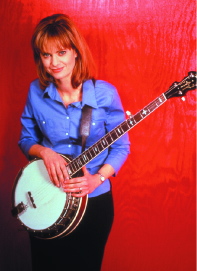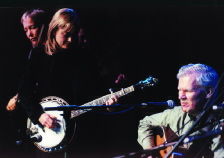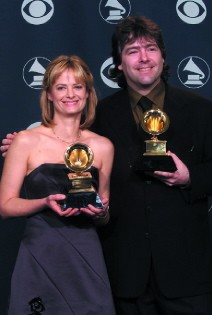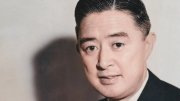 |
| Banjoist Alison Brown '84, a standout in folk, jazz, and bluegrass genres, is a rarity: a Grammy-winning artist who is also a successful record-company executive. |
| Photograph courtesy Compass Records |
Thoughts turned into chords. In 1988, Brown decided to take six months off "to work on music, try to write some music, and then get my résumé together to search for a job that was more creative." Having played the banjo seriously since age 10, she was able to join a Bay Area bluegrass band while learning jazz guitar and writing songs. That "more creative" job eventually showed up, but it didn't require a résumé. Brown has become one of the country's foremost banjo players, sometimes using an electric nylon-string banjo of her own invention. She has also broken new musical ground, fusing jazz, bluegrass, and folk idioms as part of the Alison Brown Quartet. With her husband, bassist Garry West, Brown founded a successful independent record label, Compass Records of Nashville. And in February, the music industry awarded its Grammy for best country instrumental to Brown for her song "Leaving Cottondale," from her sixth solo album, Fair Weather--which was also Grammy-nominated for best bluegrass album.
A banjo string has a ringing sound that decays very rapidly, allowing banjo-pickers to play solos of astonishing speed without muddying the notes. "Leaving Cottondale" is an exhilarating, high-velocity ride in musical improvisation with Brown and world-renowned banjoist Bela Fleck. In the "dueling banjos" tradition, Brown and Fleck play antiphonal solos, trading off riffs of increasing excitement and virtuosity that climax in what Bluegrass Magazine called "30 seconds of absolutely jaw-dropping twin-banjo counterpoint!" But unlike some banjo artists, Brown also likes to slow down the tempo. After "Leaving Cottondale," there's a long silence on the CD, perhaps to allow listeners to catch their breath; then she closes the album with "Sweet Thing," a touching ballad played without accompaniment, almost as if to prove that the banjo can also be as expressive as a viola.
The range and eclecticism of Brown's music is matched by the diverse sounds of Compass Records (www.compassrecords.com), which Brown and West launched in 1995. Compass has released more than 90 CDs, moving freely across folk, jazz, and world music. "It's music for people who like to apply their brains to the process of listening--the kind of folks who listen to NPR and like to discover wonderful things," Brown says. The Compass catalog, for example, offers former Pretenders guitarist Robbie McIntosh cheek by jowl with NewGrange, an acoustic "supergroup" that fuses jazz, bluegrass, and New Age music, and features Phil Aaborg '71 on piano.
Brown didn't record for Compass until Out of the Blue, in 1998. "Artist-run labels are usually started by the artists for themselves," she says. "But Out of the Blue was the twenty-fifth record we made. It's important that nobody thinks of Compass as a vanity label. And of course, I was under contract to Vanguard!" Her wit also shows in the name of her publishing company, Brown Knows Music.
The Compass offices are only a mile and half from Nashville's Music Row, home of the major labels and recording studios. But Compass is independent in philosophy as well as ownership. "We're in a different business," Brown explains. "The major labels start with marketing, and then they record music to satisfy demand. Our approach is the opposite. We start with great music and then use marketing to find its audience. We're more art-driven than market-driven."
 |
| Brown on banjo, with Doc Watson (right) on guitar and vocals. |
| Photograph courtesy Compass Records |
Born in Hartford, Connecticut, Brown moved with her family ("all lawyers, except me") to La Jolla, near San Diego, at age 11. Her parents had begun learning folk guitar, which Brown started at 8, but by 10 she had discovered the banjo. "I was attracted to that rippling, pinging sound," she explained in a recent Sing Out! magazine cover article. "There's no reason why I chose the banjo--it's almost as if the banjo chose me."
Brown learned the three-finger picking style--using the thumb, index, and middle fingers in a roll pattern--that Earl Scruggs, whom Brown calls "the father of bluegrass banjo," popularized in the 1940s. Immersed in such sounds and disciplines, she was a misfit in the La Jolla high-school culture of skateboarding and surfing. But luckily, "Southern California was a real hotbed of bluegrass music when I was a teenager," she wrote in the liner notes for Fair Weather. The San Diego Bluegrass Club met at Shakey's Pizza Palace, with a stage and impromptu jams in the parking lot. "There's a Southern California tradition of pizza and bluegrass," Brown reveals. At 12, she met 11-year-old fiddler Stuart Duncan (now with the double-Grammy-winning Nashville Bluegrass Band); chauffeured by Duncan's father, the two prodigies toured and played festivals in the summertime and made a bluegrass album, Pre-Sequel, before Brown left for Harvard in 1980.
 |
| Two top pluckers on a three-finger roll: banjoists Alison Brown and Bela Fleck with their Grammys. |
| Scott Greis/Image Direct |
In 1986, Brown earned an M.B.A. at UCLA. As a finance and marketing major, she had a brief internship with A & M Records. "That temporarily cured me of the desire to be in the music business," she says, laughing. "I didn't relate to the corporate culture. Musically I couldn't relate to their direction, either." But the business degree launched her two-year career as an investment banker.
Brown's post-Smith Barney exploratory hiatus segued into her current career when Alison Krauss, a precocious 16-year-old singer and fiddle player, offered a weekend job in her up-and-coming band, Union Station. "The first show I played with her was Sanders Theatre," Brown recalls. "It was the first time I ever played there." That weekend gig turned into a three-year stint; in 1990 Brown played on the Grammy-winning Krauss album I've Got That Old Feeling. The band often toured the bluegrass-roots country of southern Appalachia: Kentucky, Tennessee, North Carolina, Virginia. "We were playing for people to whom it's hot-time music," Brown recalls.
In 1990 Brown moved to Tennessee and in 1992 became the band leader for folk-pop artist Michelle Shocked. "People with Michelle were listening to more pop, R & B, and jazz," Brown says. "It was the first time I was in a band where people weren't fighting over the latest copy of Bluegrass Unlimited."
That experience fed Brown's interest in merging jazz and folk idioms with her quartet, which she formed in 1991. As in jazz, Brown explains, bluegrass solos are improvised, but "harmonically, bluegrass is really diatonic." Brown pushes limits: the bluegrass-focused Fair Weather, for example, includes covers of "Every Day I Write the Book," by pop icon Elvis Costello, and Fred Neil's "Everybody's Talkin'" from the film Midnight Cowboy. "I think that to a jazz audience, we'll always sound like folk artists, and to the folk people we'll sound jazzy," she says. "I think of myself as a folk musician. But I also play jazz guitar. And I like taking the banjo outside its conventional boundaries."
~Craig Lambert





